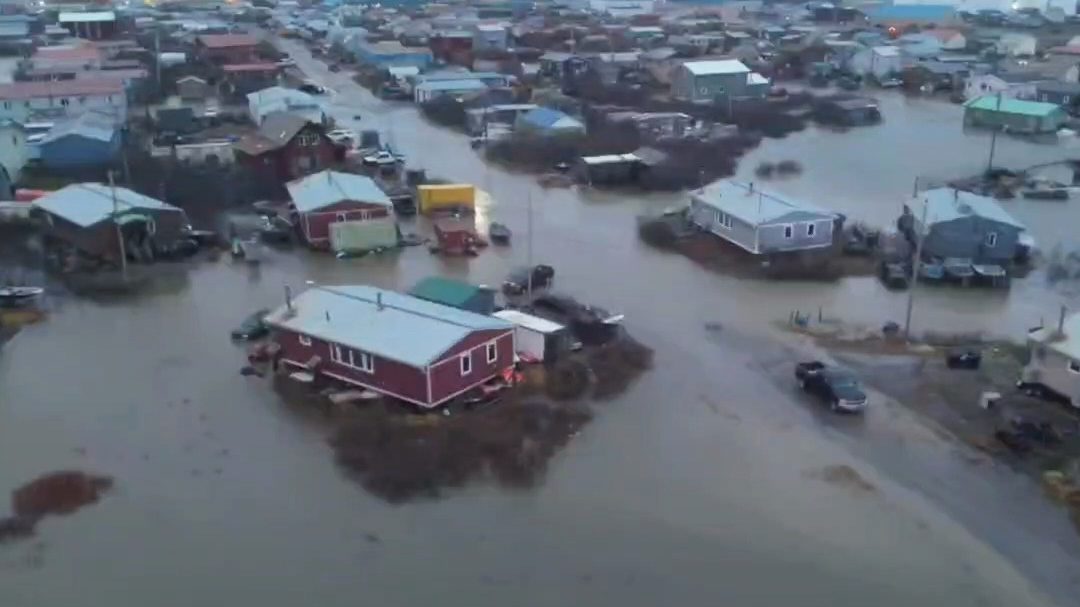A week after Typhoon Halong passed through Japan in early October, its remnants crossed the Pacific and struck western Alaska. Nearly 50 Alaska Native communities across the Yukon-Kuskokwim Delta near the Bering Sea were met with towering wind speeds, record storm surge, and widespread flooding. At least one person died, and 1,500 adults and children, who were mostly Yup’ik, were displaced from the villages. Initial estimates have reported that the storm decimated 90 percent of homes in the coastal village of Kipnuk and 35 percent in Kwigillingok, which has also experienced toxic chemicals spilling into its freshwater supply.
“It’s going to take years to recover from the disaster,” said Senator Lisa Murkowski at the Alaska Federation of Natives’ annual convention last month. “After the floodwaters recede, and after the damage to the homes and the fish camp is calculated, there’s so much work that remains, and so much healing that is needed.”
State and federal resources are being mobilized to respond to the disaster. On October 22, alongside Governor Mike Dunleavy’s state emergency declaration and release of disaster relief funds, President Donald Trump authorized a federal emergency declaration and $25 million in funds for recovery and rebuilding efforts. State agencies such as the Alaska Division of Homeland Security and Emergency Management have also begun moving evacuees into long-term housing.
“This declaration is a critical step toward recovery, but it must be the beginning of a broader, sustained response,” said Vivian Korthius, who is Yup’ik and the CEO of the Association of Village Council Presidents, in a statement.
Kipnuk and the other villages hit by the storm have been on the frontlines of climate change for more than a decade. Rising temperatures have caused permafrost to melt, causing land subsidence and flooding throughout the delta. According to the Alaska Climate Research Center, Typhoon Halong also exhibited characteristics consistent with the effects of climate change. Rising temperatures have changed the nature of tropical cyclones, leading to heavier rainfall, hurricane-like winds, and taller waves. The storm surge that struck Kipnuk, for instance, broke a 25-year-old record.
Many of the Alaska Native villages affected by Typhoon Halong were established in coastal areas as a result of the colonial policies imposed by the United States government. When the Russian Empire arrived in Alaska during the early 19th century, fur traders sought to benefit from the industry’s boom along the coastline. After Russia sold the land to the United States in 1867, the federal government aimed not only to seize and occupy lands but to encourage assimilation through boarding and day schools operated by the Bureau of Indian Affairs.
The boarding school era played a crucial role in how villages were organized. Tribal communities sought to keep their children at home, given that boarding schools forced them to live away from their tribal cultures and were associated with abuse. As a result, Yu’pik communities chose to live near and send their children to village schools run by the Bureau of Indian Affairs.
“They were told, or at least it was implied, if not told, that you need to settle here to send your kids to school, or they may be sent away to boarding school,” said Sheryl Musgrove, the climate justice programs director at the Alaska Institute for Justice, who oversees climate adaptation, mitigation, and relocation with village partners in the Yukon-Kuskokwim Delta.
The historic passage of the 1971 Alaska Native Claims Settlement Act, commonly known in the state as ANCSA, also reshaped where communities settled. The law abolished existing Native land claims in exchange for 44 million acres to be managed through private regional and village corporations. These for-profit entities, which operate in industries such as logging and oil, created jobs and encouraged settlement in centralized villages and regional hubs. As a result, settlements further solidified along the coast and near rivers.
Bonnie Jo Mount / The Washington Post via Getty Images
Given that the National Oceanic and Atmospheric Administration has predicted that Alaska’s summer waters will be ice-free in the next decade, communities have been trying to relocate with the assistance of tribal corporations. But relocating an entire village is a tall order. Costs are high, and selecting a site to relocate to with assistance from the regional corporation can be challenging. For instance, 300 people from Newtok, a village north of the Yukon-Kuskokwim Delta, moved 9 miles away to a new village known as Metarvik late last year. But the infrastructure in Metarvik is already falling apart. Electricity is intermittent, running water is lacking, and residents have had to use 5-gallon buckets as toilets. The project, which was meant to serve as a model for other villages, received millions in federal grants but ultimately lacked federal guidance and fell short of meeting residents’ needs.
Despite a different legal terrain and colonial legacy, the federal government still has treaty responsibilities to uphold toward tribes in Alaska. In May, the Environmental Protection Agency canceled a $20 million flood protection grant awarded by the Biden administration last year. This landmark grant was expected to accelerate relocation for many villages. Rescinding funding was yet another example of the lack of federal investment, Musgrove said.
Due to the severity of the storm’s impact, Kwigillingok leaders have elected to proceed with relocation. It’s a decision that the Alaska Institute for Justice will assist with.
“No one knows what the future brings, and we need serious investments in these communities like Kwigillingok and Kipnuk to be able to rebuild or relocate — whichever they choose to,” said Musgrove. “So they can be safe from that next storm, whenever that next storm is in frame.”
Source link
Miacel Spotted Elk grist.org

